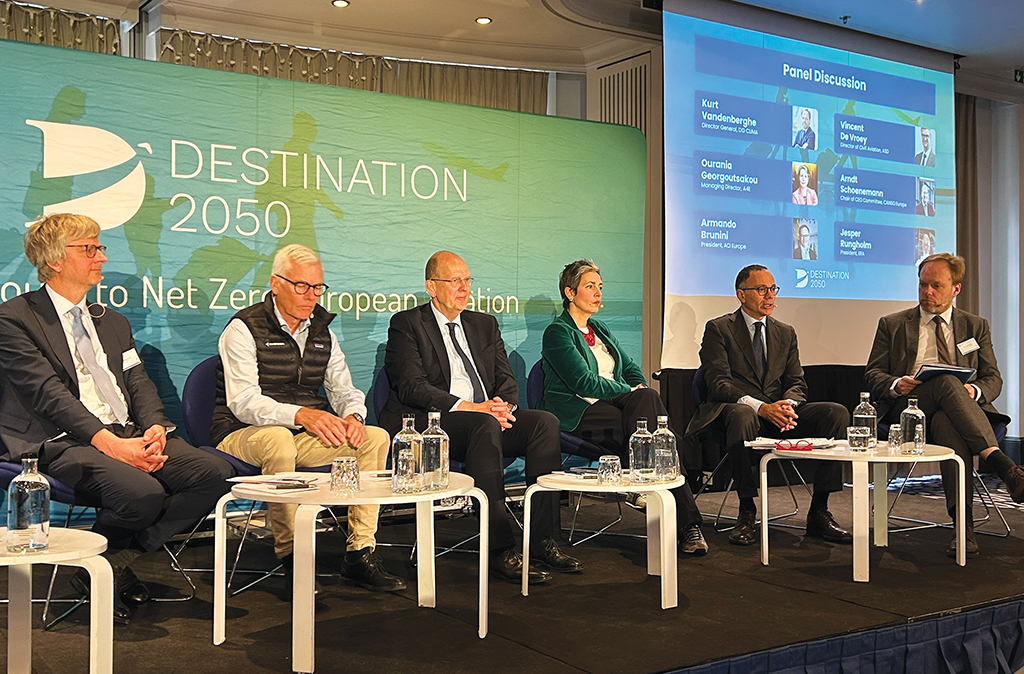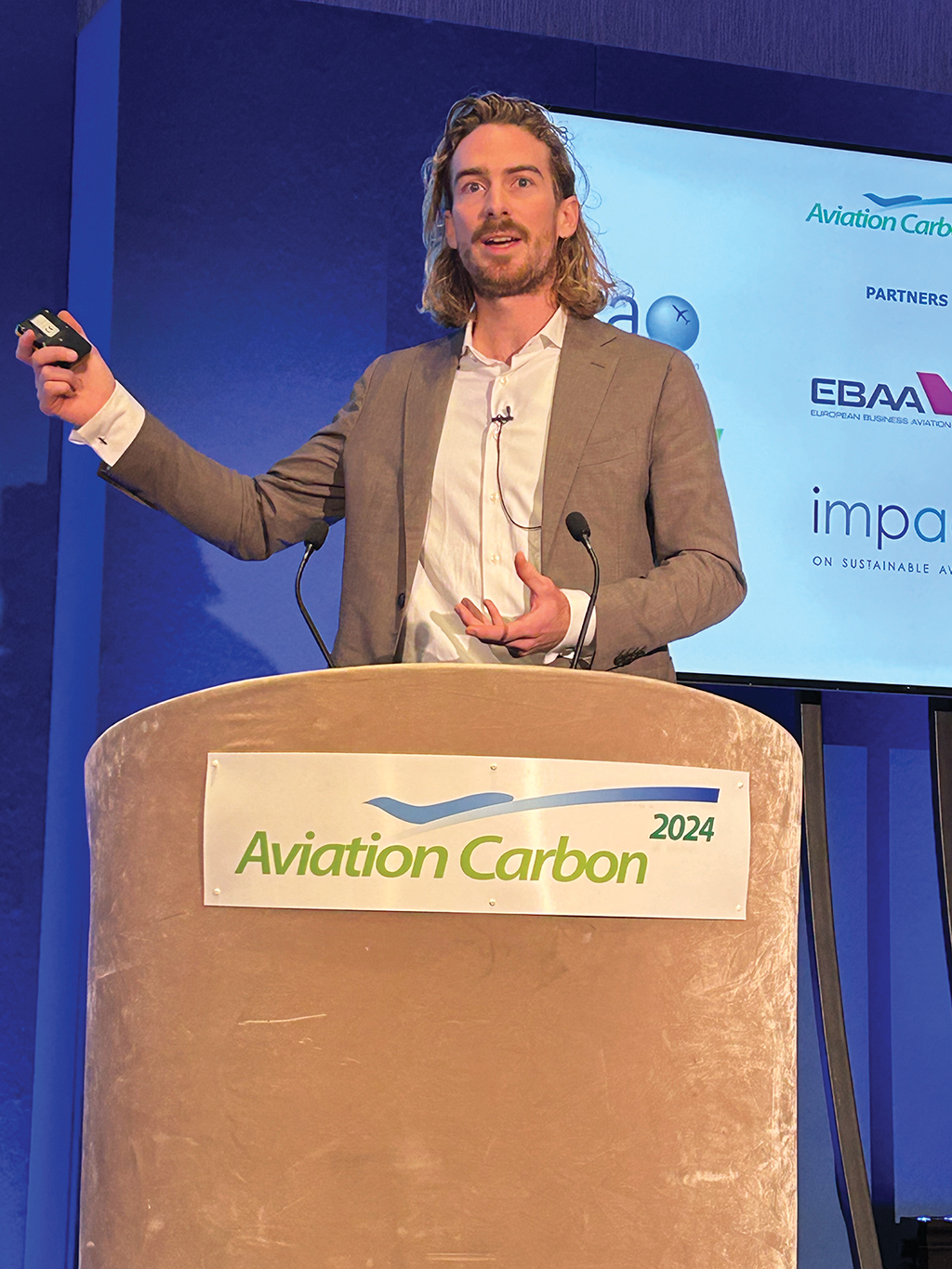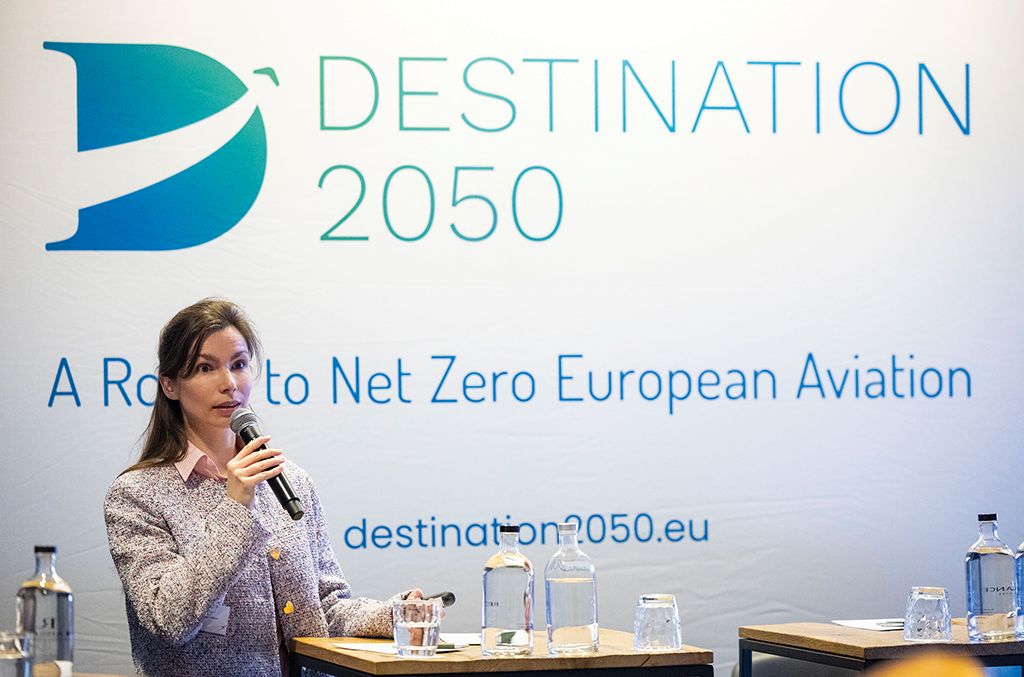This article is published in Air Transport World part of Aviation Week Intelligence Network (AWIN), and is complimentary through Apr 18, 2025. For information on becoming an AWIN Member to access more content like this, click here.

Is the goal for airlines worldwide to be carbon net zero by 2050 achievable? The goal was set by IATA at its 2021 AGM in Boston to acclaim, as was Europe’s version, called Destination 2050, but the last two years have seen skepticism and concern about the high costs of these goals, especially since the availability of affordable sustainable aviation fuel (SAF) remains far below expectations.
But hope remains.
“It’s still possible,” Airlines for Europe (A4E) managing director Ourania Georgoutsakou said. “We may need to mix and match the ingredient quantities, but the recipe is still right.” The pain point is that the estimated price of those ingredients has risen by an eye-watering €510 billion ($529 billion).

**Hydrogen was treated differently in the 2021 and 2025 reports, with part of the percentage contribution reallocated to Alternative Fuels and Sustainable Energy. Source: NLR, SEO, Destination 2050
The recipe that Georgoutsakou refers to is the Destination 2050 roadmap by the Royal Netherlands Aerospace Centre (NLR) and SEO Amsterdam Economics, which spells out how European aviation will reach net zero by 2050.
When Destination 2050 was first released in 2021, it was notable for three reasons. Firstly, it was a continental roadmap, backed by Europe’s airlines, airports, aerospace manufacturers and air navigation service providers (ANSPs). Secondly, it looked at the various sustainability measures needed to achieve net zero, breaking down the percentage contribution from each approach. This shifted the conversation from the need to reach net zero to how it would be achieved. Finally, it acknowledged that demand would be impacted by the cost of net zero; this was new.
Under the original plan, aircraft and engine technology advances—including hydrogen-powered and hybrid-electric aircraft—were expected to contribute 37% of the emissions reduction by 2050. A further 34% would come from the use of SAF; 8% from economic measures, such as the EU emissions trading system (EU ETS); and 6% from air traffic management (ATM) and operational improvements. The cost of this transition was expected to impact demand, contributing 15% of the overall emissions reduction.
In February, this recipe was updated. The four pillars remain unchanged, but the mix has shifted.

“The biggest difference from the first edition is that the contribution from hydrogen-powered aircraft has decreased,” NLR sustainable aviation team leader and Destination 2050 author Elisabeth van der Sman said. Hydrogen technologies were originally expected to contribute 20% of the emissions savings by 2050. This has been reduced to just 6%, covering both hydrogen technologies (2%) and hydrogen fuel (4%).
Conversely, technological improvements to conventionally powered aircraft were expected to contribute 17%, but this has risen to 24% in the updated report. This suggests drop-in SAFs are emerging as a more pragmatic solution than a complete aircraft and infrastructure redesign.
Returning to the four pillars, aircraft and engine technology advances now make up 26% of the emissions savings (24% for conventional technologies, plus 2% for hydrogen technologies). SAF’s contribution has increased from 34% to 39%, including 4% from hydrogen. Meanwhile, economic measures rose slightly, from 8% to 10%, while ATM and operational improvements remained unchanged at 6%.

However, two of the biggest changes underlie these headline numbers. In 2023, NLR and SEO estimated the cost of net zero at €1.89 trillion ($1.96 trillion), but at the time there was no market price for SAF. Now that actual data is available, the cost estimate has risen 27% to €2.4 trillion. “It was based on the assumption that SAF prices will go down and uptake will increase,” Georgoutsakou said. “On behalf of airlines, I can confirm to you that they [SAF prices] are in no way going down. That’s why we need to act now.”
This lays the foundation for the second underlying change. Higher SAF costs will make travel more expensive and 19% of the emissions savings will now come from dampened demand, up from 15% in the original report. These sizeable shifts show how the net zero recipe is still evolving.
“We are trying to build a reality that is a bit of an unknown in Europe and elsewhere in the world,” European Commission DG MOVE director general Magda Kopczyńska said.
Kopczyńska urged EU member states to move ahead on SAF. “Sustainable fuels do not fall from the sky,” she said.

However, Kopczyńska said she was hearing there would be enough SAF production to meet the 2025 and 2030 ReFuelEU blending mandate, although she acknowledged, “Yes, there is a pricing issue. Yes, there is a question of what will happen with those fuels and how much of them will be there after 2030,” she said.
Other industry commentators are less optimistic, particularly for the longer term. “If we take all the SAF announcements at face value, then you would get to an impression that we’re almost there. I think it’s good to talk some sense into that,” SkyNRG team lead for EU policy and sustainability Tom Berg said late last year.
SkyNRG has been monitoring SAF production capabilities since 2010 and compiling this data into a global outlook report. “We’re going to need about 500 million tons of SAF capacity by 2050, which is an astronomical amount,” Berg said. “Looking at North America, Europe and Asia-Pacific, and the targets that have been set today, we’re only getting to about 170 million tons of SAF capacity, so we have a long way to go.”
Nikhil Sachdeva, global lead for aerospace & aviation sustainability at Roland Berger, shares Berg’s concerns. “Realistically—and I’m very sorry to say this—we don’t get to net zero,” Sachdeva said. “Not only do we miss it by a small margin, we miss it by a large margin at best.”
AMBITIOUS PATHWAY
The Destination 2050 team disagrees, but they acknowledge the size of the challenge. “Without short-term action from both industry and policy makers, this ambitious pathway becomes increasingly difficult, or even impossible,” Destination 2050 author Elisabeth van der Sman said.
Destination 2050 calls on EU policy makers to create an EU aviation strategy that pulls together all the regulatory elements needed to reach net zero. This would cover financing mechanisms to support investment in SAF production, new aircraft technologies and ATM technologies, as well as continued support against the price premium of SAF. The EU is already offering a rebate of up to 100% of the price gap between SAF and conventional fuel, but this varies by location and fuel type, favoring remote airports.
This aviation strategy could feed into upcoming EU regulation, such as the Clean Industrial Deal and the Sustainable Transport Investment Plan. “The cost is not insurmountable, and the instruments are right in front of us. There’s nothing new that needs to be created,” Georgoutsakou said, noting that detailed policy recommendations were included in the Destination 2050 report.
European Commission DG CLIMA director general Kurt Vandenberghe said funding proposals were more likely to be granted when projects delivered on multiple EU policy objectives, such as competitiveness, decarbonization, security and safety, with energy security rising in importance since Russia invaded Ukraine.
European competitiveness has also become a core objective for the EC, after the Draghi report called for “radical change” in 2024. In his findings, former European Central Bank president and Brexit negotiator Mario Draghi said the EU continues to add “self-defeating” regulatory burdens, making it hard for companies to do business. Draghi estimated the cost of aviation’s green transition at €61 billion a year from 2031 to 2050.
This issue of European competitiveness was palpable at the Destination 2050 relaunch. “If we look at ReFuelEU, we can’t only look at SAF. We also have to look at carbon leakage and competitive distortion,” Lufthansa Group head of EU liaison office Ruben Schuster said. “This regulation benefits players who are outside the EU, especially those who are close to the EU, in the Bosphorus and the Gulf region. So far, ReFuelEU and Fit for 55 is a fantastic subsidy for those players. And I’m pretty sure that’s not what was intended.”
Vandenberghe at DG CLIMA said the EU was pushing for a global approach through ICAO’s CORSIA carbon offsetting scheme, but CORSIA had to be “sufficiently effective,” or the EU would extend the scope of the EU ETS to international flights. “We will do what we can to make sure that CORSIA delivers, because we are much better served by a global multilateral solution rather than a unilateral solution,” he said.
In late 2024, IATA chief economist and sustainability SVP Marie Owens Thomsen said it seemed like the EU was “out for the land grab,” ignoring ICAO’s jurisdiction over international aviation. “It looks like overstepping to me,” she said.
Vandenberghe rejected the notion that EU regulation was causing substantial carbon leakage, but he acknowledged that it could be hard to separate the impact of regulation from geopolitical events.
“We are not seeing a lot of very strong evidence of carbon leakage. I can’t say that there is none—I will not dispute that—but maybe not to the extent that we would have to fundamentally revisit our regulatory and policy framework. But I invite stakeholders to supply us with evidence of how this carbon leakage is really undermining the European aviation sector,” Vandenberghe said.
Georgoutsakou at A4E said there were at least three studies underway looking at the impact of EU policy on airline competitiveness, including carbon leakage, and the findings were imminent. “I hope that the problem will be resolved way more efficiently than in the past, and that we don’t spend our lives running studies for the next two years trying to establish whether there is a problem when, in fact, there is a reality on the market,” Georgoutsakou said. “The cost of business is increasing and that has an impact on people’s ability to fly.”
BOOK-AND-CLAIM CONTROVERSY
Another sticking point between the industry and the EC is the viability of book-and-claim, which removes the need for SAF to be transported to every airport. Under book-and-claim, an airline with no local SAF supply can buy SAF for use elsewhere. For example, Air France could buy SAF that is used by Lufthansa, but Air France would own the carbon credit; it cannot be double-claimed by Lufthansa. However, the EU has historically been reluctant to allow book-and-claim under its ReFuelEU policy because it might limit the geographical rollout of SAF.
“It’s not realistic to believe that, even in 2030 or 2035, [SAF] production will be available at every single airport in Europe, even small airports in remote places,” ACI Europe president and Aeroporto di Milano CEO Armando Brunini said. “It’s very logical to have a book-and-claim mechanism.”
Georgoutsakou sees book-and-claim as a “basic ingredient” to facilitate the SAF rollout. “Frankly, I’m disappointed that nothing has come out from the European Commission recently on book-and-claim. We’ve been waiting for some kind of clear signal and publication for a few months now, and there’s still nothing there. The [Destination 2050] report shows that we need to take action now,” she said.
Vandenberghe remains unconvinced. “I hear and understand this request for book-and-claim,” he said. “Under the EU ETS directive, currently, is that this is not possible because fuel use must be reported for flights covered by the EU ETS.”
This was not well-received by an IATA executive in the audience. “You mentioned that book-and-claim is not possible because of ETS. I think we all know it’s not a matter of possibility; it’s appetite,” the IATA executive said. “What would it take to make this technically possible, given that it wouldn’t require any funding at all?”
“Message taken,” replied Vandenberghe. “I don’t have the answer right away, but I invite you to send us ideas or suggestions on how it could be made possible under the ETS directive, in a way that we also can convince the 27 member states. We’d be happy to look at it.”
The bottom line is that the path to net zero is still a work in progress, and the Destination 2050 plan will continue to evolve as technologies mature.
“This is an ever-evolving market,” Georgoutsakou said. “When we did this the first time around, it was a recipe that no one had tested yet.”





